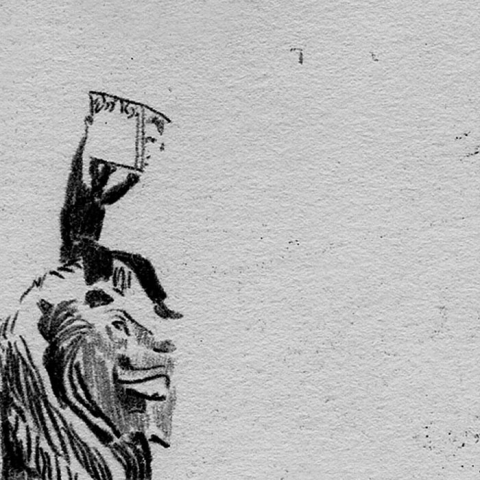Ala Younis's upcoming research-based project starts from a photograph of Gamal Abdel Nasser looking – during the signing of a sovereign union agreement between Egypt and Syria – at an enthusiastic and proud Arab crowd in 1958. We only see Nasser's back, but what was going through his mind and in the Arab world in this moment of might, unity and victory?
The promise of a sovereign union of Arab states was challenged by many regional and international forces. It was concurrent to a rocket-industry project that was on the verge of giving the Arab world unprecedented power. The gulf had just flooded with oil experts and exports. But a heart attack sent Nasser home from an Arab Summit dead. A rupture. A shock. Five million mourners marched a 10 km procession to his burial. All Arab heads of state attended. King Hussein of Jordan and PLO leader Yasser Arafat cried openly while Muammar Gaddafi of Libya reportedly fainted twice. Mourners engulfed the coffin.
In Jerusalem, roughly 75,000 Arabs marched through the Old City chanting "Nasser will never die." The Syrian Baath party declared a general mourning for 40 days in Syria. The Kuwaiti newspapers printed the image of his last escort to the Kuwaiti Emir on five columns, while Kuwaiti crowds marched the streets, schools, theaters and cinemas closed for 3 days, and a general mourning was announced for 40 days. Leipzig marched, so did Moscow who sent the Soviet Premier; only a few major Western dignitaries were present.
Some say Nasser's funeral generated the most amazing images in modern times, more than those of Ataturk's, Kennedy's and Stalin's. This project is not an enquiry into sadness or loss, it is attempt to grasp the significance of a historical figure. To look into this importance, that point of might and power that Nasser was granted in 1958, and later when it was broken on 8 June 1967 and given back on 9 June 1967, is to delve into the creation of a myth.
A finale to the trilogy of work body on Arab Nationalism that started with Nefertiti and Needles to Rockets, and Six Days, all explorations of an individual's complicated relationship to Gamal Abdel Nasser as the hero and the anti-hero, his promises and his failures, this stage of the project will be developed through a month-long residency in Cairo and will culminate in a solo exhibition at Gypsum Gallery in 2014.
Time for completion of Project: research on this project is expected to take place from June 2013.
About the artist

Ala Younis is an artist and curator. Born in Kuwait, based in Amman, graduated as an Architect from University of Jordan, Amman, Jordan in 1997. Younis's artistic practice is engaged in the reinterpretation of inherited narratives, by way of research-based sociopolitical investigations deeply explored in concurrence with personal experience. Through art, film and publication projects, she unfolds the conditions under which collective historical and political collapses can become personal ones. Her work was shown in: Tea with Nefertiti, Mathaf and Institut du Monde Arabe (2012-13), ROUNDTABLE, 9th Gwangju Biennial (2012); The Ungovernables, New Museum Triennial, New York (2012); 12th Istanbul Biennial (2011); Home Works '5, Beirut (2010); The Jerusalem Show, Jerusalem (2009), and PhotoCairo 4, Contemporary Image Collective, Cairo (2008). In 2012 she was selected by ArtReview as one of the art world's 'Future Greats 2012', and her publication projects 'Needles to Rockets' (2009), and 'Tin Soldiers' (2012) are collaborative art publications that involved in its making individuals from different backgrounds.
